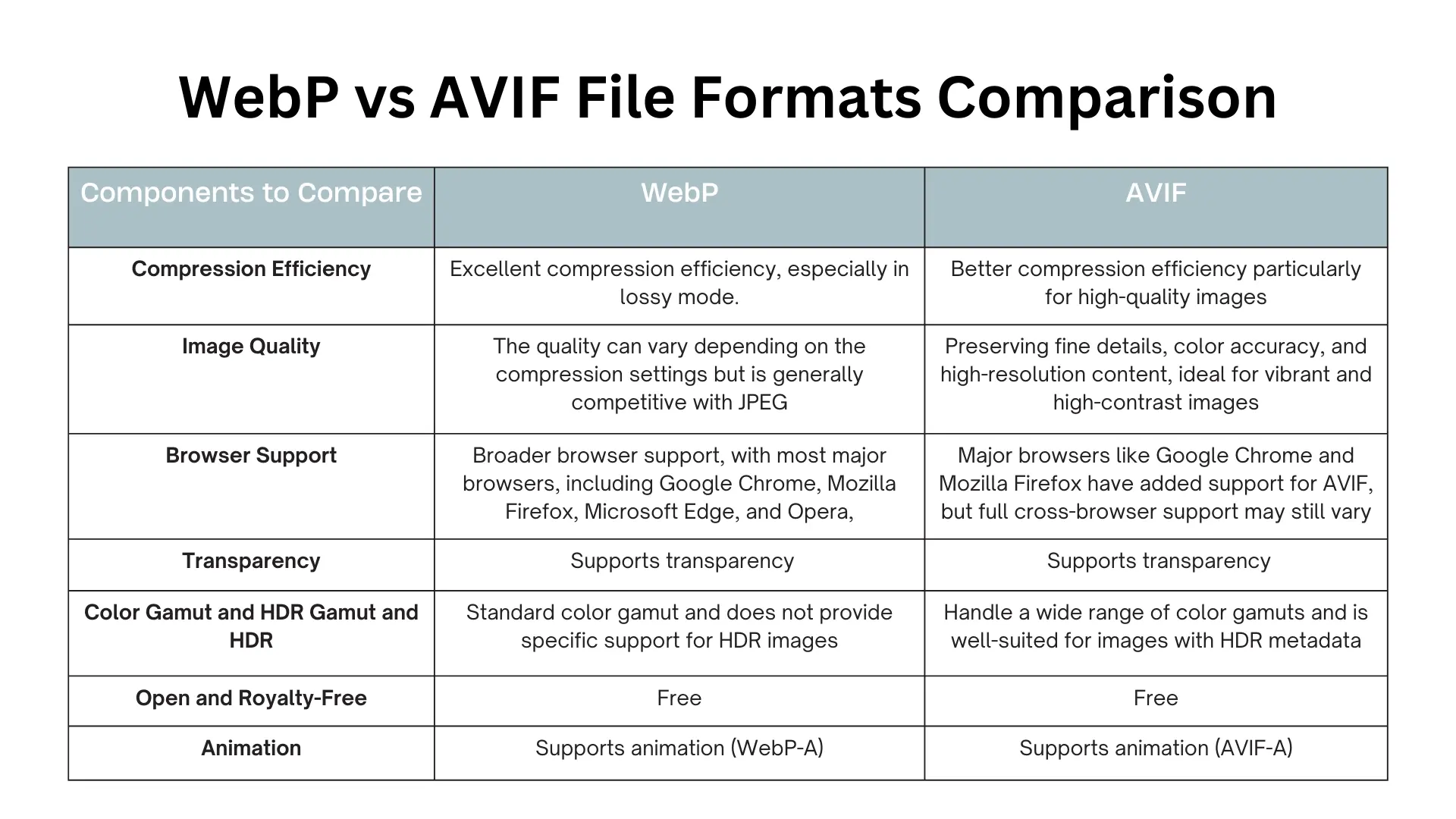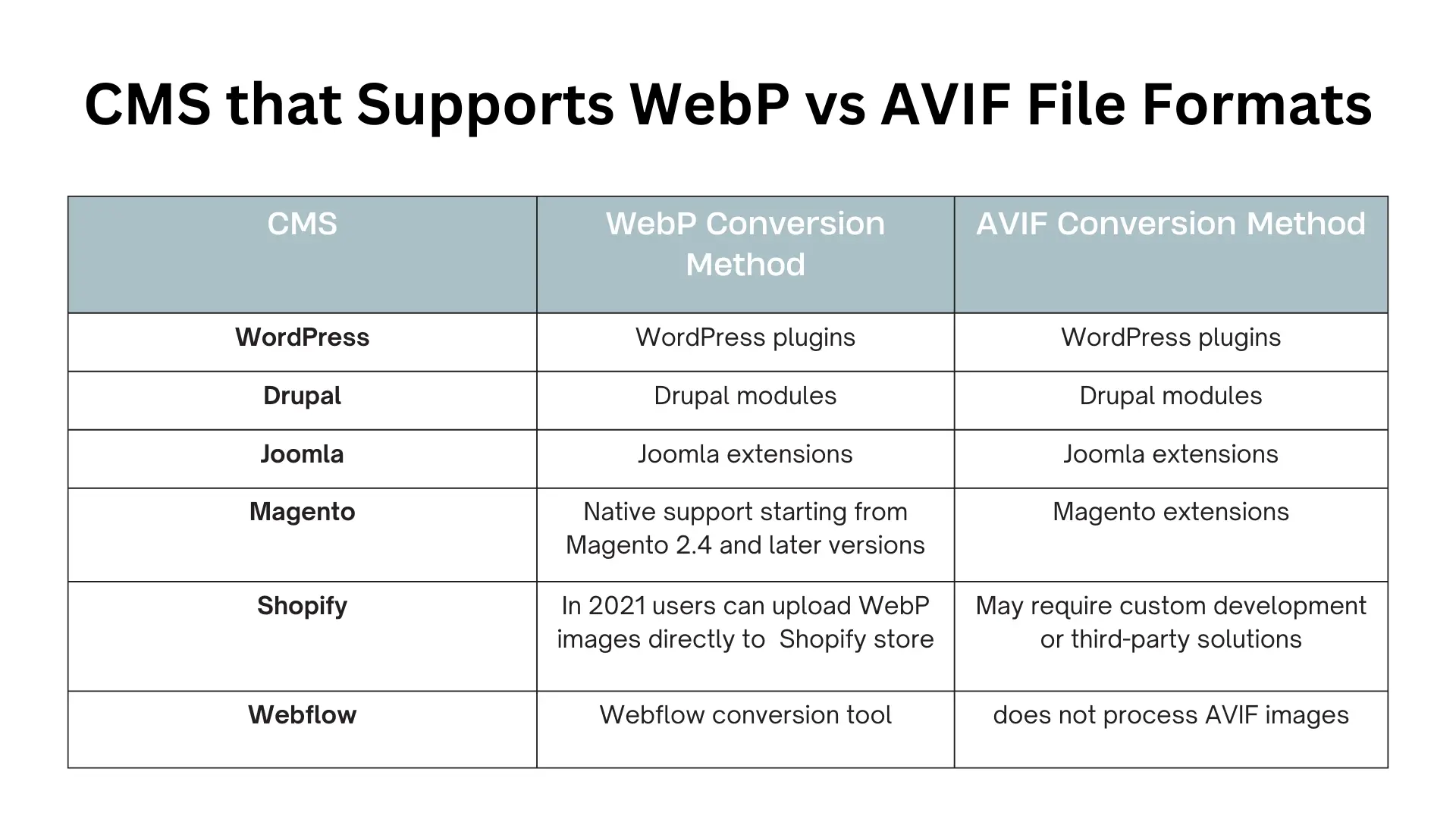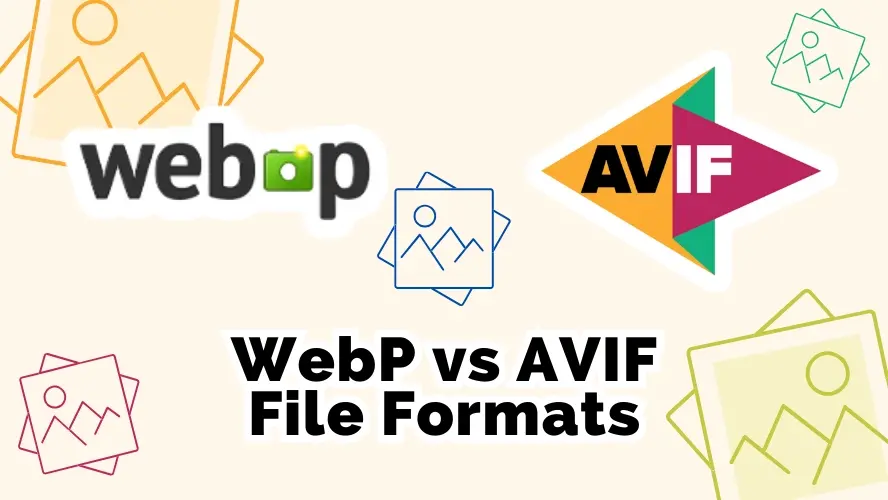WebP and AVIF are modern image file formats designed to offer better compression and image quality compared to older formats like JPEG and PNG. In lower file sizes, WebP and AVIF file formats are able to maintain high image quality which is perfect for web images that support image transparency and are free to use.
In this article, we will learn more about each of these unique image file format characteristics and compare their features. We also include an explanation of how to generate WebP and AVIF file formats and let you know which Content Management Systems support them.
Introduction to WebP and AVIF
What is the WebP File Format?
WebP is a modern image file format developed by Google. It was designed to provide efficient compression and high image quality, making it a suitable replacement for older formats like JPEG and PNG.
Overall, WebP is a versatile image format that offers a good balance between compression efficiency and image quality. It is commonly used for web images, thumbnails, and other online content where file size optimization is essential. However, it's important to consider browser support when deciding whether to use WebP for a specific project, as some older browsers may not fully support it.
What is the AVIF File Format?
AVIF, short for "AV1 Image File Format," is a modern image file format designed for efficient compression and high-quality images. It is based on the AV1 video codec, which was developed by the Alliance for Open Media (AOM) and is known for its excellent compression capabilities. AVIF extends the use of AV1 to still images, providing benefits similar to those of the AV1 video codec for images.
AVIF is particularly suitable for images where preserving high quality is essential while minimizing file sizes. It is gaining popularity, especially in web development, as it can help improve website performance by reducing image loading times. However, like any emerging format, it's important to consider browser support when deciding whether to use AVIF for a specific project, as support may vary among different web browsers and platforms.
When to Use WebP and AVIF File Formats?
WebP File Format Best Uses
Web Images
WebP is particularly well-suited for images used on websites and web applications. It offers excellent compression efficiency, which can lead to faster loading times for web pages. This is especially important for improving user experience, particularly on mobile devices and in areas with slow internet connections.
Photographs
WebP's lossy compression mode is effective for compressing photographs while maintaining reasonable image quality. It can be used for displaying high-resolution photos on websites without significantly increasing loading times.
Images with Transparency
If your images require transparency (alpha channel), WebP supports transparency and can handle images with soft edges or transparent backgrounds. This makes it suitable for icons, logos, and other graphics requiring transparency.
Animated Images
WebP includes a variant called WebP animated (WebP-A) that supports animated images. If you need to create small-sized animations for web use, WebP-A can be a good choice.
AVIF File Format Best Uses
High-Quality Images
AVIF is known for its ability to provide high-quality images with excellent compression efficiency. It excels in preserving fine details, color accuracy, and high-resolution content. If image quality is paramount for your application, especially for photographs or artwork, AVIF can be an excellent choice.
Images with Wide Color Gamuts
AVIF supports a wide range of color gamuts, making it suitable for images that require an accurate representation of vibrant and diverse colors. This is particularly important for images that involve a broad spectrum of colors, such as product images or digital art.
High Dynamic Range (HDR) Images
AVIF can store images with HDR metadata, making it ideal for images with a wide dynamic range of brightness levels. This is beneficial for capturing and displaying scenes with varying light intensities and contrasts, such as landscape or architectural photography.
Photography and Art Galleries
If you're running a photography portfolio, art gallery website, or any platform that showcases visual art, AVIF can help you maintain the highest possible image quality while keeping file sizes reasonably small.
Future-Proofing
AVIF is considered one of the most advanced image formats available, and it's expected to gain wider adoption over time. Using AVIF for your images can be a way to future-proof your content, ensuring that it remains compatible with modern devices and browsers as support for the format continues to grow.
Content Distribution
AVIF can be a valuable format for distributing high-quality images in media-rich applications, such as video streaming services, e-commerce websites, and online magazines, where image quality and performance are essential.
WebP and AVIF File Formats Comparison
Both WebP and AVIF are highly efficient image formats for web images, but the choice between them may depend on several factors, including browser support, image content, and specific use cases. Here's a list of component comparisons for both of these file formats:
Compression Efficiency
WebP
WebP is known for its excellent compression efficiency, especially in lossy mode. It can achieve significant reductions in file size while maintaining good image quality.
AVIF
AVIF is designed to provide even better compression efficiency than WebP, particularly for high-quality images. It often outperforms WebP in terms of compression ratios while preserving image quality.
Image Quality
WebP
WebP offers good image quality, particularly in lossless mode. In lossy mode, the quality can vary depending on the compression settings but is generally competitive with JPEG.
AVIF
AVIF is known for its ability to maintain high image quality at lower file sizes compared to both WebP and JPEG. It excels in preserving fine details, color accuracy, and high-resolution content.
Browser Support
WebP
WebP has broader browser support, with most major browsers, including Google Chrome, Mozilla Firefox, Microsoft Edge, and Opera, offering native support. However, support may be limited or lacking in some older browsers.
AVIF
AVIF support is growing but may not be as widely supported as WebP at the time of my last update. Some major browsers have started to add AVIF support, but it might not be universally available.
Transparency
WebP
WebP supports transparency (alpha channel), making it suitable for images with soft edges or transparent backgrounds.
AVIF
AVIF also supports transparency, allowing you to create images with transparency when needed.
Color Gamut and HDR
WebP
WebP supports a standard color gamut and does not provide specific support for HDR images
AVIF
AVIF can handle a wide range of color gamuts and is well-suited for images with HDR metadata, making it ideal for vibrant and high-contrast images.
Open and Royalty-Free
Both WebP and AVIF are open and royalty-free formats, meaning there are no licensing fees or restrictions associated with their use.

How to Generate WebP and AVIF File Formats?
1. Conversion Software
One of the most common tools for converting images to WebP is the "cwebp" command-line utility provided by Google. You can download it from the official website.
The AVIF encoder "avifenc" is available as part of the libavif library. You can download and compile it from the official GitHub repository: libavif GitHub.
2. Online Image Converter
Alternatively, there are an enormous number of web apps that you can use to convert image files which are free to use and mostly support WebP and AVIF conversion, such as Convertio.io, Online-Convert, and Squoosh. AVIF.io provides you with fast conversion for AVIF file format and it’s free.
3. Browser Extensions
Either Firefox or Chrome browsers have several extensions to choose from that allow you to convert WebP and AVIF files. Other major browsers would also provide similar extensions as these file formats would likely be often used as modern image files on the internet.
4. CMS Plugin, CMS Module, or CMS Native Converter
Most of the Content Management Systems don’t have native converters for WebP and AVIF files. However, with the increasing use of these file formats, many CMS developers have created plugins, modules, add-ons, or extensions that support WebP and AVIF files.
Many WordPress CMS plugins are developed for web image optimizers which often include WebP and AVIF file converters in their features. Webflow has a native conversion tool where users can convert existing image assets to WebP files by accessing the Webflow conversion tool in the Assets panel.

Conclusion
WebP and AVIF are both advanced image formats designed to offer efficient compression and high-quality images, but they have some key differences. Ultimately, the choice between WebP and AVIF should consider your target audience, the types of images you need to display, and your image optimization goals.
In summary, both WebP and AVIF are highly efficient image formats for the web, but AVIF tends to provide superior compression efficiency and image quality for high-quality and high-resolution images. If your target audience primarily uses modern browsers with AVIF support, it can be a compelling choice.
Remember to consider the specific use case and requirements of your images when adjusting compression settings for both WebP and AVIF. The ideal settings may vary depending on the type of images you're working with, such as photographs, graphics, or illustrations. Additionally, always check the browser support for the formats you intend to use and provide appropriate fallbacks for unsupported browsers to ensure a consistent user experience.
Frequently Asked Questions
Why should I create a website?
There are many reasons why you should create a website if you’re an artist. You can use it to create a place where people can learn about you, talk about your art, or show off your work.
How do I choose a design for my website?
One of the most important things when creating a website for your art is the design. Even though your pieces of art might be amazing, people will leave if your site is hard to navigate. This is why it’s important that the site is easy on the eyes and easy to navigate.
Are website builders easy to use?
One of the easiest ways to build a website is with a website builder. Using a website builder doesn't require any programming and coding skills.
How is the website maintenance carried out?
On a daily basis, software, hardware, vulnerability, MariaDB, CloudLinux paths and cPanel updates are carried out on our servers without a reboot. However, if we have to carry out any maintenance that includes some downtime, we schedule in advance and update our status page

Audee Mirza is a graphic designer and WordPress developer at audeemirza.com who resides in Surabaya, Indonesia. She's also the author of Graphic Identity Blog, a professional logo designer, and often creates vector illustrations for clients and marketplaces. She enjoys good typography design and all kinds of animation.
View all posts by Audee Mirza





















